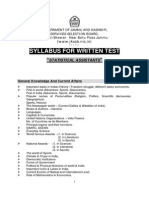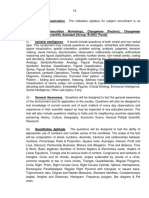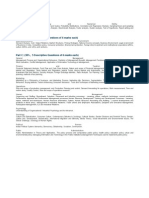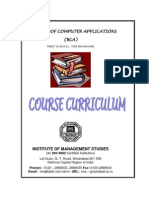GROUP-56 Common Graduate
GROUP-56 Common Graduate
Uploaded by
GaribCopyright:
Available Formats
GROUP-56 Common Graduate
GROUP-56 Common Graduate
Uploaded by
GaribOriginal Description:
Original Title
Copyright
Available Formats
Share this document
Did you find this document useful?
Is this content inappropriate?
Copyright:
Available Formats
GROUP-56 Common Graduate
GROUP-56 Common Graduate
Uploaded by
GaribCopyright:
Available Formats
GROUP-56
Common Graduate Level (Level of Exam Graduate any discipline)
1) General awareness, Reasoning, Mathematics, Science, History including Haryana related history,
current affairs, literature, Geography, Civics, Environment, Culture etc.
- (Weightage 20%)
2) Computer terminology, Fundamentals, word software, excel software, Power point, internet, web
browsing, Communication, emails, downloading and uploading data on websites etc.
- (Weightage 10%)
3) Subject related syllabus- (Weightage 70%)
--------------------------------------------------------------------------------------------------------------------------------------
A. General Intelligence &Reasoning:
It would include questions of both verbal and non-verbal type. This component may include questions
on analogies, similarities and differences, space visualization, spatial orientation, problem solving,
analysis, judgment, decision making, visual memory, discrimination, observation, relationship concepts,
arithmetical reasoning and figural classification, arithmetic number series, non-verbal series, coding and
decoding, statement conclusion, syllogistic reasoning etc. The topics are, Semantic Analogy,
Symbolic/Number Analogy, Figural Analogy, Semantic Classification, Symbolic/Number Classification,
Figural Classification, Semantic Series, Number Series, Figural Series, Problem Solving, Word Building,
Coding & de-coding, Numerical Operations, symbolic Operations, Trends, Space Orientation, Space
Visualization, Venn Diagrams, Drawing inferences, Punched hole/ pattern- folding& un-folding, Figural
Pattern-folding and completion, Indexing, Address matching, Date & city matching, Classification of
centre codes/roll numbers, Small & Capital letters/numbers coding, decoding and classification,
Embedded Figures, Critical thinking, Emotional Intelligence, Social Intelligence.
B. General Awareness:
Questions in this component will be aimed at testing the candidates’ general awareness of the
environment around him and its application to society. Questions will also be designed to test
knowledge of current events and of such matters of every day observations and experience in their
scientific aspect as may be expected of any educated person. The test will also include questions relating
to India and its neighbouring countries especially pertaining History, Culture, Geography, Economic
Scene, General Policy & Scientific Research.
Introduction to Indian Constitution: Preamble, Fundamental duties and fundamentals rights only, Traffic
Rules, Traffic signs, Penalties for violating traffic rules, first aid, safety precautions and occupational
health, Welfare Schemes run by Government of Haryana and provisions.
C. Quantitative Aptitude:
The questions will be designed to test the ability of appropriate use of numbers and number sense of the
candidate. The scope of the test will be computation of whole numbers, decimals, fractions and
relationships between numbers, Percentage. Ratio & Proportion, Square roots, Averages, Interest, Profit
and Loss, Discount, Partnership Business, Mixture and Alligation, Time and distance, Time & Work, Basic
algebraic identities of School Algebra & Elementary surds, Graphs of Linear Equations, Triangle and its
various kinds of centres, Congruence and similarity of triangles, Circle and its chords, tangents, angles
subtended by chords of a circle, common tangents to two or more circles, Triangle, Quadrilaterals,
Regular Polygons, Circle, Right Prism, Right Circular Cone, Right Circular Cylinder, Sphere, Hemispheres,
Rectangular Parallelepiped, Regular Right Pyramid with triangular or square base, Trigonometric ratio,
Degree and Radian Measures, Standard Identities, Complementary angles, Heights and Distances,
Histogram, Frequency polygon, Bar diagram & Pie chart.
D. Hindi & English Language:
Candidates’ ability to understand correct Hindi/English, his/her basic comprehension and writing ability,
Hindi & English terms used in offices and inter-translation etc. would be tested.
E: Economics and Governance:
Comptroller & Auditor General of India & Haryana- Constitutional provisions, Role and responsibility.
Finance Commission- Role and functions.
Basic Concept of Economics and introduction to Micro Economics: Definition, scope and nature of
Economics, Methods of economic study and Central problems of an economy and Production
possibilities curve.
Theory of Demand and Supply: Meaning and determinants of demand, Law of demand and Elasticity of
demand, Price, income and cross elasticity; Theory of consumer’s behaviour Marshallian approach and
Indifference curve approach, Meaning and determinants of supply, Law of supply and Elasticity of Supply
Theory of Production and cost: Meaning and Factors of production; Laws of production- Law of variable
proportions and Laws of returns to scale.
Forms of Market and price determination in different markets: Various forms of markets-Perfect
Competition, Monopoly, Monopolistic Competition and Oligopoly and Price determination in these
markets.
Haryana economy: nature, characteristics and problems; concept of economic development; State of
the Haryana economy since its inception: Income; Population, Health & Nutrition and declining sex ratio,
Haryana agriculture: nature, cropping pattern, role of agriculture in Haryana economy, Measures for
development in agriculture, crop insurance, Agriculture credit: agriculture finance, types of agriculture
finance; credit needs of farmers; sources of credit: institutional and non-institutional sources; NABARD;
rural indebtedness: causes, consequences and debt relief measures, Micro, small & medium enterprises
(MSME) in Haryana: meaning, role, performance and challenges; SEZ, Growth of MNCs in Haryana, Role
of HSIIDC, HFC, HAFED, HKVIB, Haryana budget: objectives and policies, sources of revenues and its
utilization.
Rural Marketing: meaning, nature, characteristics; opportunities and challenges to rural markets in
Haryana; Socio-cultural, economic, demographic, technological and other environmental factor affecting
rural marketing; rural consumer behaviour; segmentation of rural market; strategies for rural marketing;
rural marketing mix; difference in rural and urban market; problems in rural marketing; Strategies for
rural marketing, Product planning, pricing, promotion and management of distribution channels for
marketing of durables and non-durables in rural areas; Planning and organizing personnel selling in rural
markets; Innovation in rural market; E-commerce in rural markets, e-chaupal& other similar initiatives in
rural markets.
FUNDAMENTALS OF INSURANCE: Introduction to insurance, Contract of life insurance, Fire insurance,
Marine insurance, Accident and motor insurance, Farm Crop Insurance, Insurance intermediaries – role
of agents and procedure for becoming an agent; cancellation of license;
revocation/suspension/termination of agent appointment; code of conduct; unfair practices.
F. Environmental Studies and Disaster Management
Multidisciplinary nature of environmental studies, Natural Resources, Forest resources, Water resources,
Mineral resources, Food resources, Energy resources, Land resources, Ecosystems, Energy flow in the
ecosystem, Introduction, types, characteristic features, structure and function of the following
ecosystem: a. Forest ecosystem b. Grassland ecosystem c. Desert ecosystem d. Aquatic ecosystems
(ponds, streams, lakes, rivers, oceans, estuaries). Biodiversity and its conservation, Value of biodiversity,
Hot-sports of biodiversity, Threats to biodiversity, Endangered and endemic species of India.
Conservation of biodiversity, Environmental Pollution, effects and control measures of: a. Air pollution b.
Water pollution c. Soil pollution d. Marine pollution e. Noise pollution f. Thermal pollution g. nuclear
hazards. Solid Waste Management, Social Issues and the Environment, Environmental ethics, Wasteland
reclamation, Consumerism and waste products. Environment Protection Act. Air (Prevention and Control
of Pollution) Act. Water (Prevention and control of Pollution) Act. Wildlife Protection Act. Forest
Conservation Act. Issues involved in enforcement of environmental legislation. Public awareness. Human
Population and the Environment, Environment and human health, Role of Information Technology in
Environment and human health.
DISASTER MANAGEMENT: Natural Disasters, Climatic change, Man Made Disasters, Disaster
Management, International strategy for disaster reduction, national disaster management framework;
financial arrangements; role of NGOs, community –based organizations and media. Central, state, district
and local administration; Armed forces in disaster response; Disaster response; Police and other
organizations.
NOTE- The questions in Parts A, B, D, E & F will be of a level commensurate with
the essential qualification viz. Graduation and questions in Part-C will be of 10th
standard level.
Important Note: The Weightage as mentioned against the syllabus is tentative & may vary.
You might also like
- Sustainable Development Class 10Document16 pagesSustainable Development Class 10Niranj Mass86% (90)
- Group 56 Common Graduate LevelDocument3 pagesGroup 56 Common Graduate LevelSonu SagarNo ratings yet
- GROUP-57 Common Higher SecondaryDocument3 pagesGROUP-57 Common Higher Secondaryyadavrohit1474292No ratings yet
- Group 57 Common Senior SecondaryDocument3 pagesGroup 57 Common Senior SecondaryAmit SharmaNo ratings yet
- CET Haryana 12th Level Mains Exam New Syllabus 11 March 2023Document3 pagesCET Haryana 12th Level Mains Exam New Syllabus 11 March 2023Talim100% (1)
- Comm Adm TestDocument1 pageComm Adm TestTZ VersionNo ratings yet
- Casesyllabus Sarkariresult ComDocument3 pagesCasesyllabus Sarkariresult ComHimanshu kumarNo ratings yet
- XH - B1 Reasoning and Comprehension (Compulsory For All XH Candidates)Document15 pagesXH - B1 Reasoning and Comprehension (Compulsory For All XH Candidates)Hriday Jyoti BarmanNo ratings yet
- Upsc SyllabusDocument5 pagesUpsc SyllabusPsp Flying beast fanNo ratings yet
- Uttarakhand Public Service Commission Ukpsc Syllabus State Pcs EnglishDocument5 pagesUttarakhand Public Service Commission Ukpsc Syllabus State Pcs EnglishpreetiNo ratings yet
- Phase I: Quantitative AptitudeDocument3 pagesPhase I: Quantitative AptitudeVinay KumarNo ratings yet
- UPSC Exam Syllabus 2017 For Mains - Subjects & PapersDocument5 pagesUPSC Exam Syllabus 2017 For Mains - Subjects & Paperssaurav chandanNo ratings yet
- HSSC Patwari Exam SyllabusDocument6 pagesHSSC Patwari Exam SyllabusCehNo ratings yet
- Part-A Preliminary Examination Paper I - (200 Marks) Duration: Two HoursDocument7 pagesPart-A Preliminary Examination Paper I - (200 Marks) Duration: Two HoursHarsha DeepakNo ratings yet
- Syllabi For The Examination: Part A-Preliminary Examination Paper IDocument11 pagesSyllabi For The Examination: Part A-Preliminary Examination Paper IPratap Singh ChouhanNo ratings yet
- Current Affairs: History of India Indian and World GeographyDocument10 pagesCurrent Affairs: History of India Indian and World GeographySam JoseNo ratings yet
- Untitled 1Document7 pagesUntitled 1Suresh RamNo ratings yet
- Ocs 2015 Syllabus PDFDocument157 pagesOcs 2015 Syllabus PDFBikash Kumar NayakNo ratings yet
- CSAT (Prelims) Pattern: Prelims Paper Duration Questions MarksDocument12 pagesCSAT (Prelims) Pattern: Prelims Paper Duration Questions MarksSunil GarnayakNo ratings yet
- SSC CGL Syllabus - CompleteDocument10 pagesSSC CGL Syllabus - CompleteshwetasruthiNo ratings yet
- Part-B Main Examination Qualifying Papers On Indian Languages and EnglishDocument6 pagesPart-B Main Examination Qualifying Papers On Indian Languages and EnglishAmoghNo ratings yet
- PDFDocument68 pagesPDFAiman LatifNo ratings yet
- Detailed SyllabusDocument3 pagesDetailed Syllabusdummyem1234No ratings yet
- Paper 1: Essay (250 Marks) Paper 2: General Studies Paper 1 (250 Marks)Document3 pagesPaper 1: Essay (250 Marks) Paper 2: General Studies Paper 1 (250 Marks)Pradeep SinghNo ratings yet
- Paper 1: Essay (250 Marks) Paper 2: General Studies Paper 1 (250 Marks)Document3 pagesPaper 1: Essay (250 Marks) Paper 2: General Studies Paper 1 (250 Marks)Pradeep SinghNo ratings yet
- Syllabus Headmaster 13-09-11Document5 pagesSyllabus Headmaster 13-09-11Nishant ThapaNo ratings yet
- DSSRB SyllabusDocument2 pagesDSSRB SyllabusStanley WangchokNo ratings yet
- Upsc Mains SyllabusDocument5 pagesUpsc Mains SyllabusMihir PawarNo ratings yet
- Navy Incet 01 2024 Exam Syllabus - Pdf-CompressedDocument4 pagesNavy Incet 01 2024 Exam Syllabus - Pdf-Compressedcs1117875No ratings yet
- Upsc Cse SyllabusDocument8 pagesUpsc Cse Syllabusvarshithaks30No ratings yet
- GATE - XH - 2025 - SyllabusDocument12 pagesGATE - XH - 2025 - Syllabusnainsingh0514No ratings yet
- General Intelligence & Reasoning: It Would Include Questions of Both Verbal and Non-VerbalDocument1 pageGeneral Intelligence & Reasoning: It Would Include Questions of Both Verbal and Non-VerbalAnkit SinghNo ratings yet
- JKPSC Mains SyllabusDocument9 pagesJKPSC Mains Syllabuswaniarbaz28No ratings yet
- SyyyyyDocument2 pagesSyyyyysachinNo ratings yet
- Upsc Mains SyllabusDocument4 pagesUpsc Mains Syllabusnitish chahalNo ratings yet
- upsc-syllabus-2024-25Document3 pagesupsc-syllabus-2024-25soojeshahirNo ratings yet
- Civil Services Mains Exam 2014 Syllabus: The Written Examination Will Consist of The Following PapersDocument7 pagesCivil Services Mains Exam 2014 Syllabus: The Written Examination Will Consist of The Following PapersDevi BeheraNo ratings yet
- Rajasthan Public Service Commission, AjmerDocument4 pagesRajasthan Public Service Commission, AjmerjujofegiNo ratings yet
- Annexure "A"Document27 pagesAnnexure "A"haroon012023No ratings yet
- Preliminary Examination Paper I - (200 Marks) Duration: Two HoursDocument5 pagesPreliminary Examination Paper I - (200 Marks) Duration: Two HoursrajmastiNo ratings yet
- Indian Heritage and Culture, History and Geography of The World and SocietyDocument21 pagesIndian Heritage and Culture, History and Geography of The World and SocietyMadhumitha PodishettyNo ratings yet
- SSC CHSL Syllabus 2023 30d7aab4Document3 pagesSSC CHSL Syllabus 2023 30d7aab4tiwarivaibhav990No ratings yet
- SyllabusDocument3 pagesSyllabusPuran SinghNo ratings yet
- Bcs Written Full SyllabusDocument8 pagesBcs Written Full SyllabusNirala NirjanaNo ratings yet
- Upsc Syllabus WifiDocument19 pagesUpsc Syllabus WifiNIKHIL REDDYNo ratings yet
- General Studies I: Indian Heritage and Culture, History and Geography of The World and SocietyDocument5 pagesGeneral Studies I: Indian Heritage and Culture, History and Geography of The World and SocietyJohnny PrinceNo ratings yet
- UPSE Mains Electrical Engineering SyllabusDocument13 pagesUPSE Mains Electrical Engineering SyllabusPriyanka TrivediNo ratings yet
- Rajasthan Public Service CommissionDocument17 pagesRajasthan Public Service CommissionOmendra SharmaNo ratings yet
- SyllabiDocument7 pagesSyllabiHARSHIT PRAJAPATINo ratings yet
- Upsc Syllabus For Paper I - (200 Marks) Duration: Two Hours (Counted For The Merit Rank in The Prelims)Document6 pagesUpsc Syllabus For Paper I - (200 Marks) Duration: Two Hours (Counted For The Merit Rank in The Prelims)NaveenNo ratings yet
- Part A: (40% MCQS) : Research Methodology and Numerical AbilityDocument1 pagePart A: (40% MCQS) : Research Methodology and Numerical AbilityDr-Ajay SinghNo ratings yet
- Kas Syllabus: Syllabi For The ExaminationDocument4 pagesKas Syllabus: Syllabi For The ExaminationMouliNo ratings yet
- CSE Mains SyllabusDocument7 pagesCSE Mains SyllabusSushil KumarNo ratings yet
- Bachelor of Computer Applications (BCA) : Institute of Management StudiesDocument24 pagesBachelor of Computer Applications (BCA) : Institute of Management StudiesgauravjainisNo ratings yet
- Syllabus For Agribusiness Management (COQP01)Document80 pagesSyllabus For Agribusiness Management (COQP01)Sachin PalNo ratings yet
- XH - B1 Reasoning and Comprehension (Compulsory For All XH Candidates)Document15 pagesXH - B1 Reasoning and Comprehension (Compulsory For All XH Candidates)Gouri NairNo ratings yet
- Mapping Community Health: GIS for Health and Human ServicesFrom EverandMapping Community Health: GIS for Health and Human ServicesNo ratings yet
- Sustainability and Resilience Planning for Local Governments: The Quadruple Bottom Line StrategyFrom EverandSustainability and Resilience Planning for Local Governments: The Quadruple Bottom Line StrategyNo ratings yet
- Finding a Sustainable Balance: GIS for Environmental ManagementFrom EverandFinding a Sustainable Balance: GIS for Environmental ManagementSunny FlemingNo ratings yet
- Urban Forests: A Global PerspectiveFrom EverandUrban Forests: A Global PerspectiveNo ratings yet
- Conservation Biology - 2003 - Denton - A Recovery Program For The Natterjack Toad Bufo Calamita in BritainDocument10 pagesConservation Biology - 2003 - Denton - A Recovery Program For The Natterjack Toad Bufo Calamita in BritainFerranNo ratings yet
- ECOLOGY-1 (Compatibility Mode)Document6 pagesECOLOGY-1 (Compatibility Mode)Tony Sdj100% (1)
- Exclusive Inquiry: Battle Lines DrawnDocument12 pagesExclusive Inquiry: Battle Lines DrawnNation OnlineNo ratings yet
- MiningDocument114 pagesMiningM Ansari100% (2)
- Inter Writing T2.8 ENVIRONMENT READINGDocument6 pagesInter Writing T2.8 ENVIRONMENT READINGNguyễn Mai AnhNo ratings yet
- English Mindmap 2Document6 pagesEnglish Mindmap 2Jeffrey VictoryNo ratings yet
- Oleh/By: Ismayadi Samsoedin I Wayan Susi Dharmawan Dan/and Chairil Anwar SiregarDocument10 pagesOleh/By: Ismayadi Samsoedin I Wayan Susi Dharmawan Dan/and Chairil Anwar SiregarAdnanNo ratings yet
- Study Material Part 1 Evs Aecc Notes 1st Year DuDocument131 pagesStudy Material Part 1 Evs Aecc Notes 1st Year Durajeshpanda159No ratings yet
- Master Plan For Agricultural Development in Southern Delta of BangladeshDocument21 pagesMaster Plan For Agricultural Development in Southern Delta of BangladeshkhmahbubNo ratings yet
- In Text Questions Class10Document6 pagesIn Text Questions Class10Anonymous convuaNo ratings yet
- Bina Agarwal Alternative ConceptualisationsDocument1 pageBina Agarwal Alternative Conceptualisationssakshi ugaleNo ratings yet
- Fall On EarhingDocument19 pagesFall On Earhingعلي عدنان عز الدين جواد الموسويNo ratings yet
- Chattanooga Biosolids Disposal On Four Farms. 3 in Warren and 1 in Van Buren. NOV and Site Photo Document SignedDocument14 pagesChattanooga Biosolids Disposal On Four Farms. 3 in Warren and 1 in Van Buren. NOV and Site Photo Document SignedDan LehrNo ratings yet
- LS2 Work SamplesDocument5 pagesLS2 Work SamplesVhince LicupNo ratings yet
- 09PHFST102 PDFDocument266 pages09PHFST102 PDFRajesh PantNo ratings yet
- 21.6 Human Influences On Ecosystems Igcse Cie Biology Ext Theory QPDocument10 pages21.6 Human Influences On Ecosystems Igcse Cie Biology Ext Theory QPSinda13No ratings yet
- Crop Rotation On Vegetable FarmsDocument3 pagesCrop Rotation On Vegetable FarmsChing QuiazonNo ratings yet
- CYANOBACTERIADocument2 pagesCYANOBACTERIADaniele CamposNo ratings yet
- Biodiversity ConventionDocument31 pagesBiodiversity Conventionaarzoo dadwalNo ratings yet
- Pidato Bahasa InggrisDocument2 pagesPidato Bahasa InggrisSwan DanaNo ratings yet
- 8 Hours Environmental Management Training Course For Managing Heads (Online)Document2 pages8 Hours Environmental Management Training Course For Managing Heads (Online)Rubie Anne SaducosNo ratings yet
- Environmental. (Climate Change) ClassmateDocument3 pagesEnvironmental. (Climate Change) ClassmateELaine Nadera-SarmientoNo ratings yet
- Carbon PricingDocument10 pagesCarbon PricingCarol CNo ratings yet
- Biome BookDocument11 pagesBiome Bookapi-317802596No ratings yet
- Biology Form 4 Chapter 9-Endangered Ecosystem Power PointDocument65 pagesBiology Form 4 Chapter 9-Endangered Ecosystem Power PointDelima Adan100% (1)
- City of Malmö 2006Document8 pagesCity of Malmö 2006MwemeziNo ratings yet
- COMM2789 A2 Semester1 2022Document14 pagesCOMM2789 A2 Semester1 2022bimbimcuaaiNo ratings yet
- Alice JohnsonDocument2 pagesAlice JohnsonDouangdy SlvNo ratings yet
- 4594 Malaysia IC-CFS Project Document 07-01-2014 (Final Prodoc)Document227 pages4594 Malaysia IC-CFS Project Document 07-01-2014 (Final Prodoc)Ridzuan NainaNo ratings yet

























































































